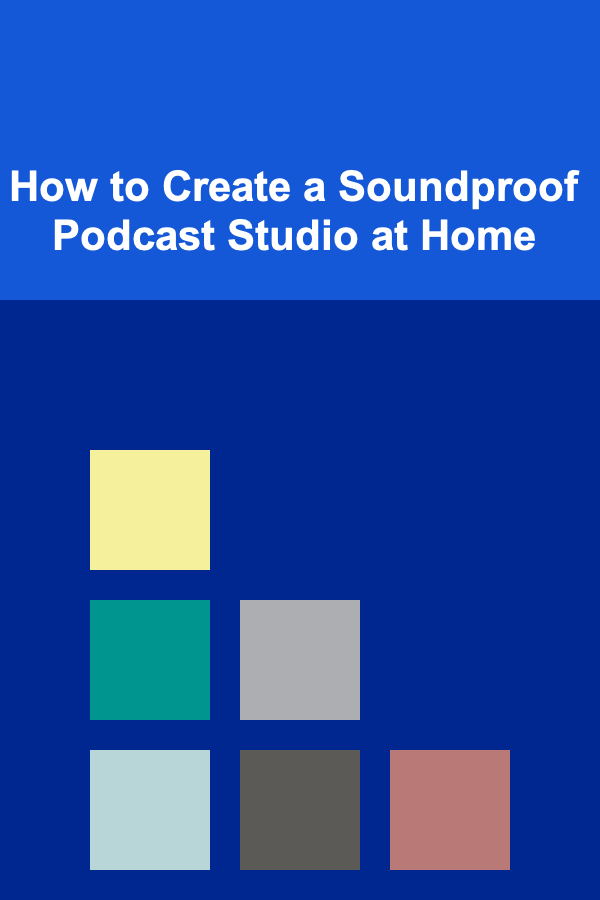
How to Create a Soundproof Podcast Studio at Home
ebook include PDF & Audio bundle (Micro Guide)
$12.99$6.99
Limited Time Offer! Order within the next:

Podcasting has become a popular form of communication and entertainment, but creating high-quality audio content requires more than just a microphone and a recording device. The environment where you record plays a significant role in the clarity and professionalism of your audio. If you're serious about starting your own podcast or improving your existing recordings, creating a soundproof podcast studio at home should be a priority. This guide will walk you through the process, offering tips and strategies for setting up your own soundproof space, from choosing the right room to investing in acoustic treatment and equipment.
Understanding the Importance of Soundproofing for Podcasting
Before diving into the technical details, it's important to understand why soundproofing is crucial for podcasting.
The Impact of Sound on Podcast Quality
Podcasts are an audio-based medium, meaning the listener's experience depends entirely on the clarity of the sound. Background noise, echoes, and reverb can detract from the listener's experience, making it harder for them to follow the conversation and enjoy the content. Poor sound quality can even result in your audience losing interest or becoming frustrated with the listening experience.
A soundproof studio minimizes external noise and controls the acoustics within the recording space, resulting in cleaner, more professional audio. This is essential not only for ensuring that your voice is captured clearly but also for eliminating distractions from things like traffic, household noise, or room echoes.
The Difference Between Soundproofing and Acoustic Treatment
While these terms are often used interchangeably, there is a subtle difference between soundproofing and acoustic treatment. Soundproofing focuses on preventing sound from entering or leaving a room, whereas acoustic treatment focuses on improving the sound quality inside the room by managing sound reflections and absorption.
For podcasting, you will need to address both issues: soundproofing to keep external noises from disturbing your recording and acoustic treatment to ensure optimal sound quality.
Choosing the Right Room for Your Podcast Studio
The first step in creating a soundproof podcast studio at home is selecting the right room. You don't need a large space, but the room should meet certain criteria to make the soundproofing and recording process easier.
Key Factors to Consider When Selecting a Room
- Isolation from External Noise: The room should be as isolated as possible from outside noise. Avoid choosing rooms that share walls with noisy areas like the kitchen, living room, or streets. Rooms with fewer windows and external-facing walls tend to perform better in terms of sound isolation.
- Shape and Size: Ideally, you want a room that is not perfectly square, as square rooms tend to create more standing waves (low-frequency sound reflections). A room with irregular dimensions is better for controlling these sound issues. A smaller room can often be better for soundproofing, as it requires fewer materials to treat.
- No Windows or Easy-to-Cover Windows: Windows are one of the main sources of sound leakage in a room. If possible, choose a room without windows, or one with windows that are easy to cover or soundproof.
- Quiet Neighbors and Low Traffic Areas: If you live in an apartment or have other people in the household, you should choose a room that's away from areas of heavy foot traffic and noise.
Soundproofing the Room
Once you've chosen the right room, it's time to focus on soundproofing. While it's nearly impossible to achieve perfect soundproofing without extensive remodeling, there are several ways to drastically reduce noise interference.
1. Seal Gaps and Cracks
Sound can leak through even the tiniest gaps, so the first step is sealing any cracks or openings in the room. Pay close attention to:
- Door Gaps: Sound can leak through the gap beneath the door, or through spaces around the doorframe. Use a door sweep or weatherstripping to seal the bottom of the door. You can also add a heavy-duty door seal around the edges of the doorframe to block sound.
- Windows: If your room has windows, these are typically the weakest point for sound leakage. You can cover them with thick curtains or blinds to absorb sound. Alternatively, you can install acoustic window inserts to reduce external noise without sacrificing natural light.
- Wall Cracks: Any cracks in the walls should be sealed with caulking or acoustical sealant. This is a low-cost method that can significantly reduce sound leakage.
2. Add Mass to the Walls
The more mass a wall has, the better it will be at blocking sound. Adding mass to the walls can help reduce noise transmission. Here are some strategies:
- Mass-Loaded Vinyl (MLV): MLV is a heavy material that can be applied to walls, ceilings, and floors to add mass and block sound transmission. MLV is flexible, so it can be attached to walls without disrupting the overall appearance of the room.
- Drywall: If you're willing to invest more time and money, adding an additional layer of drywall to the walls can help absorb sound. Be sure to use a soundproofing compound like Green Glue between the layers to further improve sound isolation.
- Acoustic Panels: Acoustic panels can also add mass to the walls while also providing sound absorption. You can purchase pre-made acoustic panels or even make your own using dense materials like foam or fiberglass.
3. Treat the Ceiling and Floor
Sound doesn't just enter through walls---it can also come from above or below. To soundproof the ceiling and floor, consider these methods:
- Acoustic Ceiling Tiles: Installing acoustic tiles on the ceiling can help absorb sound and reduce noise coming from above. You can also apply a layer of mass-loaded vinyl or drywall to further isolate sound.
- Carpeting and Rugs: Hardwood floors and tiles can create sound reflections that disrupt your recording. Adding thick carpeting or large rugs will help absorb sound and reduce echo in the room.
- Isolation Pads: If you have heavy equipment like a microphone stand or desk that could transmit vibrations to the floor, consider using isolation pads beneath them. These pads can help isolate the equipment and reduce vibrations that might travel through the floor.
Acoustic Treatment for the Studio
Once your room is soundproofed, the next step is to improve the acoustics of the space. This will help eliminate echoes and ensure the sound captured by your microphone is clean and clear.
1. Use Acoustic Panels
Acoustic panels are essential for controlling sound reflections inside the room. They absorb sound waves, preventing them from bouncing off hard surfaces and creating reverb or echo. When choosing acoustic panels, focus on materials like foam or fiberglass, which are designed to absorb sound effectively.
2. Bass Traps for Low-Frequency Control
Low frequencies (bass) tend to accumulate in corners, causing unwanted rumbling sounds or distortion in recordings. Bass traps are designed to absorb these low frequencies and help balance the acoustics in the room. Place bass traps in the corners of the room to effectively control these frequencies.
3. Diffusers for Even Sound Distribution
While absorption is important, it's also essential to maintain a natural sound distribution in the room. Diffusers scatter sound waves, preventing them from concentrating in certain areas. Using diffusers can help create a balanced and clear acoustic environment without over-dampening the room.
4. Strategic Placement of Panels
To optimize the acoustic treatment, you need to strategically place the panels in areas where sound reflections are most likely to occur. These areas include the first reflection points (where sound bounces off the walls before reaching your microphone), the ceiling, and the corners of the room. Experiment with panel placement to find the best configuration for your recording environment.
Choosing the Right Equipment
A soundproof podcast studio isn't complete without the right recording equipment. While microphones and audio interfaces are essential, choosing the right gear can also improve the overall sound quality of your podcast.
1. Microphone Selection
The microphone you choose will have the most significant impact on your recording quality. Consider the following types of microphones:
- Dynamic Microphones: These are great for podcasting because they are less sensitive to background noise and will pick up sound only from the front. They are durable and often used in professional settings.
- Condenser Microphones: While more sensitive and capable of capturing more detail, condenser microphones tend to pick up more ambient noise, making them less ideal for untreated rooms. However, with proper acoustic treatment, they can deliver excellent sound quality.
2. Audio Interface and Preamp
An audio interface connects your microphone to your computer, converting the analog sound into digital data. A preamp boosts the signal from the microphone, ensuring clear and high-quality recordings. Look for an interface with high-quality preamps and the necessary input for your microphone type.
3. Headphones and Monitoring
Accurate monitoring is essential for ensuring your recordings are clean and free of distortion. Invest in high-quality headphones or studio monitors for precise monitoring of your podcast.
Final Thoughts
Creating a soundproof podcast studio at home may seem like a daunting task, but with the right planning and effort, you can create a professional recording environment. By carefully selecting your room, soundproofing the space, and using the right acoustic treatments and equipment, you can ensure that your podcast stands out with clear, high-quality audio. Whether you're recording in your bedroom or converting a spare room, the time and money you invest in soundproofing will pay off in the long run by improving your podcast's audio experience.

How to Automate Your Social Media Posting for Consistent Branding
Read More
How to Lock Your Home Properly for Maximum Security
Read More
How to Set Realistic Financial Goals Before Investing
Read More
How to Teach Teens Smart Financial Habits for the Future
Read More
How to Secure Your Webcams and Microphones: Protecting Your Privacy in the Digital Age
Read More
How to Fly a Drone for Real Estate Photography
Read MoreOther Products

How to Automate Your Social Media Posting for Consistent Branding
Read More
How to Lock Your Home Properly for Maximum Security
Read More
How to Set Realistic Financial Goals Before Investing
Read More
How to Teach Teens Smart Financial Habits for the Future
Read More
How to Secure Your Webcams and Microphones: Protecting Your Privacy in the Digital Age
Read More